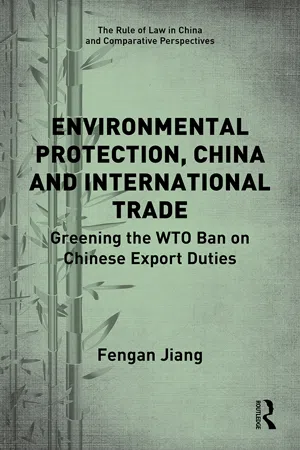
Environmental Protection, China and International Trade
Greening the WTO Ban on Chinese Export Duties
- 248 pages
- English
- ePUB (mobile friendly)
- Available on iOS & Android
Environmental Protection, China and International Trade
Greening the WTO Ban on Chinese Export Duties
About This Book
This book argues for a balanced approach to 'greening' the World Trade Organization (WTO) ban on China's export duties without opening the floodgates to protectionism.
As a result of the China—Raw Materials and China—Rare Earths decisions, China is largely prohibited from using export duties to address environmental problems, including those associated with climate change. This is despite a number of climate studies having suggested that Chinese export duties could be useful for reducing carbon leakage, an issue of international concern. This book puts the case for a more balanced approach. It shows that a harsh ban on China's export duties constrains its policy space to protect the environment, particularly in the context of climate change. The work presents feasibility tests for various legal solutions that have been discussed for adjusting the ban, and it accordingly proposes a more feasible approach that would allow China to help protect the environment without advancing protectionism. The proposed legal option provides a less protectionist alternative to export duties, namely 'export duties plus': export duties in combination with supplementary restrictions on Chinese consumption. This analysis also yields insights regarding ways to correct WTO precedents, which suggests a moderate alternative response to an important issue behind the Appellate Body crisis.
The book will be a valuable resource for academics, researchers and policymakers in the areas of International Trade Law, Environmental Law and China.
Frequently asked questions
Information
1 Introduction
1.1 Should WTO law allow China to use export duties to address trade-related environmental concerns and, if so, what form should these duties take?
Table of contents
- Cover
- Half Title
- series Page
- Title Page
- Copyright Page
- Dedication
- Table of Contents
- List of illustrations
- Acknowledgements
- List of Abbreviations
- 1. Introduction
- PART I Setting the scene: The background and reception of the WTO ban on Chinese export duties
- PATRT II Preliminary analysis: Would a harsh prohibition on Chinese export duties constrain China’s capacity to protect the environment?
- PART III Final analysis: Is there a way for China to use export duties legally in order to achieve environmental goals under WTO law?
- Index